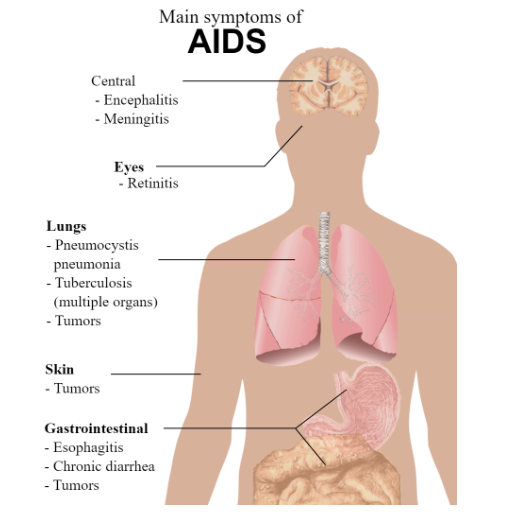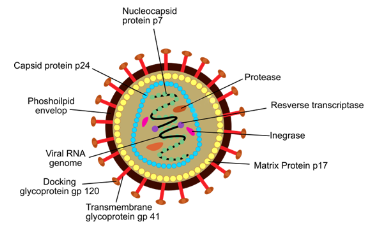Table of Contents
AIDS (Acquired Immunodeficiency Syndrome), is a medical condition characterized by a range of infections that occur due to the gradual deterioration of immune system cells caused by HIV (Human Immunodeficiency Virus). AIDS is the advanced stage of HIV infection. Despite being asymptomatic for several years, individuals with HIV can experience the virus actively attacking their immune system. Tragically, in the two decades following the initial reporting of five cases in 1981, approximately 22 million people lost their lives to AIDS. Presently, an estimated 35 to 40 million individuals globally are living with HIV.

Mode of Transmission
HIV spreads most effectively through actions involving the exchange of blood or bodily fluids between people since the virus is found in these substances.
Transmission occurs through sexual activities involving semen or vaginal fluid, encompassing unprotected anal, vaginal, or oral sex.
Direct contact between contaminated blood and non-infected blood, such as sharing needles among intravenous drug users or accidental needle sticks among healthcare workers, also leads to transmission.
HIV can pass from an infected mother to her baby during childbirth or breastfeeding.
Preventive Healthcare
In India, the National AIDS Control Organization (NACO) and Non-Governmental Organisations (NGOs) collaborate to raise awareness about HIV/AIDS. NACO focuses on policies, prevention, treatment, and information dissemination. NGOs conduct grassroots outreach, behavior change programs, stigma reduction, and testing services. Mass media campaigns are also used to spread accurate information and reduce stigma.
- The use of latex condoms significantly reduces the likelihood of HIV transmission during vaginal or anal intercourse, though it cannot eliminate the risk entirely.
- Public health initiatives targeting the avoidance of needle sharing have been successful in curbing the rise of new HIV cases among drug users.
- Administering specific drugs to pregnant women with HIV substantially diminishes the chances of transmitting the virus to their infants.
HIV is a fragile virus that cannot survive outside the human body for extended periods. It is not transmitted through insect bites, casual physical contact (like hugging), or sharing household items.
HIV Structure
HIV consists of a central core containing ribonucleic acid (RNA), enveloped by a protein coat called a capsid. HIV is categorized as a retrovirus due to its genetic information being stored in RNA instead of the typical DNA. The capsid is enclosed by an envelope composed of a lipid bilayer that contains glycoproteins.

HIV Replication
When a virus infects a host cell, it harnesses the cell’s internal enzymes and ribosomes to produce numerous copies of itself. These newly generated viruses are then released from the host cell to infect other cells.
- The process of HIV infection commences with the binding of its glycoproteins to receptors on the host cell’s plasma membrane.
- This binding prompts the cell to internalize the virus via receptor-mediated endocytosis.
- Within the host cell, HIV discards its protein coat, and an enzyme named reverse transcriptase becomes active. This enzyme reads the viral RNA and generates a DNA copy.
- This viral DNA then integrates into the host cell’s DNA, becoming part of the cell’s genetic material.
- Consequently, the viral DNA gets replicated along with the host cell’s DNA during regular cell division. Moreover, the viral DNA stimulates the infected cell to produce numerous copies of viral RNA and assemble protein coats for each copy.
- The newly formed HIV copies are released from the cell’s plasma membrane, circulating in the bloodstream to infect other cells.
The primary target of HIV’s detrimental effects is helper T cells. The rate of viral replication can be very high, yielding over 10 billion viral copies each day. This rapid production frequently leads to the bursting of infected cells (cell lysis). Additionally, the immune system attempts to eliminate infected cells, effectively killing them, although not all the viruses within. In the initial stages of HIV infection, the body can often replace destroyed helper T cells at a comparable pace. Yet, after a number of years, the capacity of the body to replace these cells diminishes, resulting in a gradual decline in the number of circulating helper T cells.
Symptoms
Upon contracting an HIV infection, a majority of individuals experience a brief episode resembling flu-like symptoms. These symptoms commonly include fever, fatigue, rash, headache, joint pain, sore throat, and swollen lymph nodes. Specialised cells known as plasma cells initiate the production of antibodies targeted against HIV within 3 to 4 weeks of infection. These antibodies can be identified in the blood plasma. A positive HIV test result generally indicates the presence of antibodies to HIV antigens in the individual’s bloodstream.
The progression to AIDS typically spans over 2 to 10 years, during which HIV destroys a sufficient number of helper T cells. This destruction leads to symptoms of immunodeficiency like swollen lymph nodes, chronic fatigue, involuntary weight loss, night sweats, skin rashes, diarrhoea, and various lesions affecting the mouth and gums. Moreover, the virus may extend its reach to neurons in the brain, leading to cognitive impairments, memory issues, and visual disturbances.
As the immune system gradually weakens, individuals with HIV infection become susceptible to a range of opportunistic infections. These infections arise from microorganisms that are ordinarily kept in check by a healthy immune system but can proliferate due to the compromised immunity caused by HIV. The diagnosis of AIDS is established when the count of helper T cells falls below 200 cells/mm3 of blood or when opportunistic infections emerge—whichever occurs first. Eventually, it’s often opportunistic infections that become the primary cause of death in individuals with AIDS.
Treatment
As of now, there is no cure for HIV infection. Vaccines aimed at preventing new HIV infections and decreasing the viral load (the quantity of HIV RNA copies in a microliter of blood plasma) in those already infected are undergoing clinical trials. Currently, three classes of drugs are effective in prolonging the lives of many HIV-infected individuals:
- Reverse transcriptase inhibitors: These drugs obstruct the activity of reverse transcriptase, the enzyme HIV employs to convert its RNA into a DNA copy. Notable drugs in this category include zidovudine (ZDV, previously AZT), didanosine (ddI), and stavudine (d4T). Trizivir, which was approved in 2000 for HIV treatment, combines three reverse transcriptase inhibitors in a single pill.
- Integrase inhibitors: Integrase inhibitors target the enzyme integrase, responsible for inserting the HIV DNA copy into the DNA of the host cell. Raltegravir is an example of an integrase inhibitor.
- Protease inhibitors: These drugs interfere with the function of protease, a viral enzyme responsible for cutting proteins into segments to construct the protein coat of newly formed HIV particles. Drugs such as nelfinavir, saquinavir, ritonavir, and indinavir fall into this category.
- Highly Active Antiretroviral Therapy (HAART) is the recommended treatment for HIV-infected patients. HAART involves a combination of three or more antiretroviral medications from at least two different classes of inhibitor drugs. HAART is associated with high costs, demanding dosing schedules, and potentially severe side effects that not everyone can tolerate.
Despite drug treatment leading to a near absence of HIV in the blood (resulting in a “negative” blood test for HIV), the virus typically persists in various lymphatic tissues. Consequently, an infected individual can still transmit the virus to another person in such cases.
Summary
AIDS, caused by HIV, is a progressive condition characterized by immune system cell degradation and resultant infections. While HIV can be asymptomatic for years, it actively targets the immune system. Over two decades, around 22 million people succumbed to AIDS. HIV is primarily transmitted through blood and bodily fluids exchange, especially through unprotected sexual activities, needle sharing among drug users, and from mother to child during childbirth or breastfeeding. Preventive measures include condom use, avoiding needle sharing, and administering drugs to pregnant women. HIV’s structure consists of RNA in a protein coat with the glycoprotein-enveloped lipid bilayer. It enters host cells, reproducing through reverse transcription and DNA integration. Infected cells eventually burst, and the immune system attacks both infected cells and the virus. Early symptoms involve flu-like illness, and progression to AIDS, marked by helper T cell loss, leads to opportunistic infections. Antiretroviral drugs are used for treatment, particularly Highly Active Antiretroviral Therapy (HAART), which significantly suppresses viral load and boosts T cell count. Despite treatment, residual virus in lymphatic tissues can still facilitate transmission.
FAQs on Aids
What is AIDS?
Acquired Immunodeficiency Syndrome (AIDS) is a medical condition resulting from the progressive destruction of immune system cells by the Human Immunodeficiency Virus (HIV). It represents the advanced stage of HIV infection and is characterized by a range of infections due to compromised immune function.
How does HIV spread?
HIV is most effectively transmitted through activities involving the exchange of blood or bodily fluids. This includes unprotected sexual intercourse, sharing needles among intravenous drug users, and from an infected mother to her child during childbirth or breastfeeding.
Can HIV be cured?
Currently, there is no cure for HIV infection. While vaccines and treatments are being researched, there is no definitive cure available. Antiretroviral therapies are used to manage the virus and its effects.
What are the symptoms of HIV infection?
Shortly after infection, many individuals experience flu-like symptoms such as fever, fatigue, rash, headache, joint pain, sore throat, and swollen lymph nodes. These symptoms can appear within 3 to 4 weeks after contracting HIV.
What is the difference between HIV and AIDS?
HIV (Human Immunodeficiency Virus) is the virus that causes AIDS. AIDS (Acquired Immunodeficiency Syndrome) is the final stage of HIV infection, marked by severe immune system suppression and a higher vulnerability to opportunistic infections.
How does HIV affect the immune system?
HIV specifically targets and destroys helper T cells, a key component of the immune system. This leads to compromised immunity, making the body susceptible to various infections and diseases.
Can HIV be transmitted through casual contact?
No, HIV cannot be transmitted through casual contact like hugging or sharing household items. It requires direct exchange of blood or bodily fluids for transmission.
Are there any vaccines for HIV?
While vaccines are being developed to prevent new HIV infections and reduce viral load, there is currently no widely approved vaccine for HIV.
Can a person with HIV live a normal life?
With proper medical care and adherence to antiretroviral treatments, many people with HIV can lead long and relatively healthy lives. However, it requires ongoing medical management and attention to health considerations.









